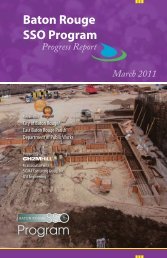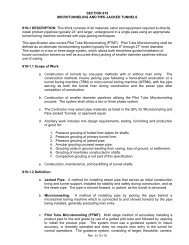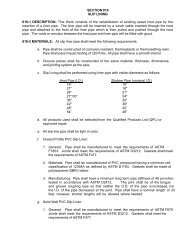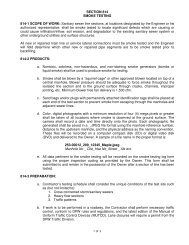Contents
Construction Management Plan - Baton Rouge Department of Public ...
Construction Management Plan - Baton Rouge Department of Public ...
- No tags were found...
You also want an ePaper? Increase the reach of your titles
YUMPU automatically turns print PDFs into web optimized ePapers that Google loves.
• Follow all excavation entry requirements established by the competent person.<br />
• Sloping, benching, shoring, shielding, or other protective systems are required to protect<br />
personnel from cave-ins except when the excavation is made entirely in stable rock or is less<br />
than 5 feet deep and there is no indication of possible cave-in, as determined by the excavation<br />
competent person.<br />
• Trenches greater than 4 feet deep shall be provided with a ladder, stairway, or ramp positioned<br />
so that the maximum lateral travel distance is no more than 25 feet.<br />
• Guardrails, fences, or barricades shall be installed at excavations 6 feet or deeper when the<br />
excavations are not readily visible because of plant growth or other visual obstruction.<br />
• Do not enter excavations where protective systems are damaged or unstable.<br />
• Do not enter excavations where objects or structures above the work location may become<br />
unstable and fall into the excavation.<br />
• Do not enter excavations with the potential for a hazardous atmosphere until the air has been<br />
tested and found to be at safe levels.<br />
• Do not enter excavations with accumulated water unless precautions have been taken to<br />
prevent excavation cave-in.<br />
• H&S Self-Assessment Checklist – Excavations, found in Attachment 6 of this plan, is an example<br />
of the type of evaluation that shall be used to inspect excavation activity prior to entry.<br />
2.2.14 Fall Protection<br />
(Reference CH2M HILL SOP HSE&Q-308, Fall Protection)<br />
• Fall protection systems must be used to eliminate fall hazards when performing construction<br />
activities at a height of 6 feet or greater and when performing general industry activities at a<br />
height of 4 feet or greater.<br />
• CH2M HILL Staff exposed to fall hazards must complete initial fall protection training by<br />
completing either the CH2M HILL 10-Hour Construction Safety Awareness training course or<br />
the Fall Protection computer-based training module. Staff must also receive project-specific fall<br />
protection training. Staff shall not use fall protection systems for which they have not been<br />
trained.<br />
• The DSC must complete the Project Fall Protection Evaluation Form presented in Attachment 5<br />
of this plan and provide project-specific fall protection training to all CH2M HILL staff exposed<br />
to fall hazards.<br />
• When CH2M HILL designs or installs fall protection systems, staff shall be qualified as fall<br />
protection competent persons or work directly under the supervision of a CH2M HILL fall<br />
protection competent person.<br />
• The company responsible for the fall protection system shall provide a fall protection competent<br />
person to inspect and oversee the use of fall protection system. CH2M HILL staff shall be aware<br />
of and follow all requirements established by the fall protection competent person for the use<br />
and limitation of the fall protection system.<br />
• When horizontal lifelines are used, the company responsible for the lifeline system shall<br />
provide a fall protection qualified person to oversee the design, installation, and use of the<br />
horizontal lifeline.<br />
• Only one person shall be simultaneously attached to a vertical lifeline and shall also be attached<br />
to a separate independent lifeline.<br />
GNV310133632156.DOC/090840008 A-21












